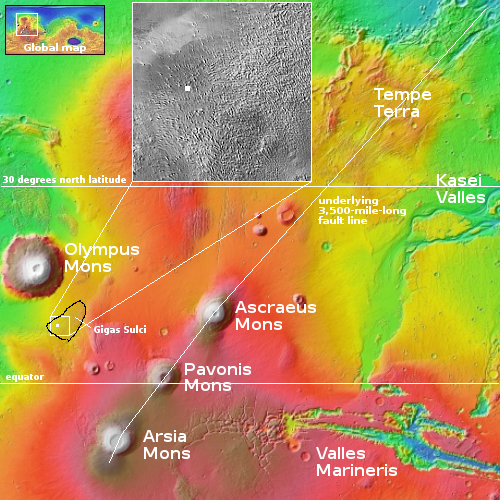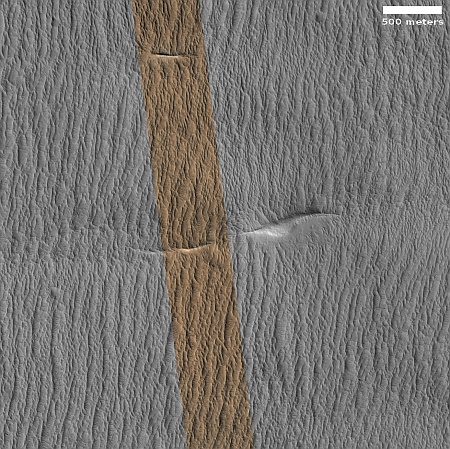Hardened dunes or eroded lava?
Cool image time! The picture to the right, cropped, reduced, and sharpened to post here, was taken on August 4, 2024 by the high resolution camera on Mars Reconnaissance Orbiter (MRO). It is labeled as a “terrain sample,” so it likely was taken not as part of any specific research project but to fill a gap in the schedule in order to maintain the camera’s proper temperature.
The picture shows a flat rippled plain with a handful of very small thin ridges, oriented 90 degrees from the smaller ripples and sticking up a few feet above them.
The rough surface of the small ripples suggest these are dunes of sand that have hardened into rock. The thin larger ridges suggest an underlying topography buried by the sand. The dunes however might not be dunes at all, as indicated by their location.

The white dot on the overview map to the right marks the location, on the western edge of a 400-mile-wide region of parallel ridges dubbed Gigas Sulci (as outlined by the black line). While planetary scientists think the smaller ripples in the hollows of this region are dunes, the shape and placement of the entire region suggests its creation is related to an eruption that occurred from Olympus Mons, or from its southeastern flanks.
If so, it could be that the hollows are not hardened sand dunes but ancient dunes of volcanic ash that has been eroded over time. The larger ridges meanwhile are likely flood lava that covered the region in a much earlier volcanic event and is now largely buried by that sand or ash.
Why that flood lava hardened into these vertical ridges is unclear. Maybe it too got eroded over time to produce this stippled surface that is now mostly buried by ash.
Or maybe not. The geology here is really more complicated than I can figure.
On Christmas Eve 1968 three Americans became the first humans to visit another world. What they did to celebrate was unexpected and profound, and will be remembered throughout all human history. Genesis: the Story of Apollo 8, Robert Zimmerman's classic history of humanity's first journey to another world, tells that story, and it is now available as both an ebook and an audiobook, both with a foreword by Valerie Anders and a new introduction by Robert Zimmerman.
The print edition can be purchased at Amazon or from any other book seller. If you want an autographed copy the price is $60 for the hardback and $45 for the paperback, plus $8 shipping for each. Go here for purchasing details. The ebook is available everywhere for $5.99 (before discount) at amazon, or direct from my ebook publisher, ebookit. If you buy it from ebookit you don't support the big tech companies and the author gets a bigger cut much sooner.
The audiobook is also available at all these vendors, and is also free with a 30-day trial membership to Audible.
"Not simply about one mission, [Genesis] is also the history of America's quest for the moon... Zimmerman has done a masterful job of tying disparate events together into a solid account of one of America's greatest human triumphs."--San Antonio Express-News
Cool image time! The picture to the right, cropped, reduced, and sharpened to post here, was taken on August 4, 2024 by the high resolution camera on Mars Reconnaissance Orbiter (MRO). It is labeled as a “terrain sample,” so it likely was taken not as part of any specific research project but to fill a gap in the schedule in order to maintain the camera’s proper temperature.
The picture shows a flat rippled plain with a handful of very small thin ridges, oriented 90 degrees from the smaller ripples and sticking up a few feet above them.
The rough surface of the small ripples suggest these are dunes of sand that have hardened into rock. The thin larger ridges suggest an underlying topography buried by the sand. The dunes however might not be dunes at all, as indicated by their location.

The white dot on the overview map to the right marks the location, on the western edge of a 400-mile-wide region of parallel ridges dubbed Gigas Sulci (as outlined by the black line). While planetary scientists think the smaller ripples in the hollows of this region are dunes, the shape and placement of the entire region suggests its creation is related to an eruption that occurred from Olympus Mons, or from its southeastern flanks.
If so, it could be that the hollows are not hardened sand dunes but ancient dunes of volcanic ash that has been eroded over time. The larger ridges meanwhile are likely flood lava that covered the region in a much earlier volcanic event and is now largely buried by that sand or ash.
Why that flood lava hardened into these vertical ridges is unclear. Maybe it too got eroded over time to produce this stippled surface that is now mostly buried by ash.
Or maybe not. The geology here is really more complicated than I can figure.
On Christmas Eve 1968 three Americans became the first humans to visit another world. What they did to celebrate was unexpected and profound, and will be remembered throughout all human history. Genesis: the Story of Apollo 8, Robert Zimmerman's classic history of humanity's first journey to another world, tells that story, and it is now available as both an ebook and an audiobook, both with a foreword by Valerie Anders and a new introduction by Robert Zimmerman.
The print edition can be purchased at Amazon or from any other book seller. If you want an autographed copy the price is $60 for the hardback and $45 for the paperback, plus $8 shipping for each. Go here for purchasing details. The ebook is available everywhere for $5.99 (before discount) at amazon, or direct from my ebook publisher, ebookit. If you buy it from ebookit you don't support the big tech companies and the author gets a bigger cut much sooner.
The audiobook is also available at all these vendors, and is also free with a 30-day trial membership to Audible.
"Not simply about one mission, [Genesis] is also the history of America's quest for the moon... Zimmerman has done a masterful job of tying disparate events together into a solid account of one of America's greatest human triumphs."--San Antonio Express-News



Seen this?
https://x.com/chrisramsay52/status/1885360546347672021
https://x.com/Radios4Freedom/status/1885548698064535956
Actual pictures or fakes?
Kevin: I am fairly certain those are actual pictures. Regardless, I don’t take the claims in the first seriously for many reasons:
1. It’s an old picture from Mars Global Surveyor, which did great work a quarter of a century ago but was not at the highest resolution.
2. The picture has clearly been doctored, in a manner to confirm the conclusions. When I adjust an image I always do it for the whole image, and not to make a uncertain theory more certain. I also always describe all changes. In this case Ramsey clearly changed the image to prove his point, in an unacceptable way, and made no mention of his changes.
3. No location for the image is provided. If you’re going to make such a claim you should allow others to easily check up on it. For example, what does more recent images show? And what does the original look like? As shown by the second link, the original picture looks nothing like the doctored one.
This kind of stupidity gets pushed all the time. I wish people would stop being so credulous.
And finally, reason number 4, the most important. If any Mars orbital picture had been detected any artificial structures suggesting alien life, it would be blasted loudly by the scientists involved. Such a discovery would be maybe the most important in the history of science. Why would any scientist keep it secret? The payoff for them in fame and glory would be priceless.
https://viewer.mars.asu.edu/planetview/inst/moc/E1000462#T=2&P=E1000462
At the top of this image.
I have found a Mars Reconnaissance Orbiter (MRO) image, taken by the context camera. Click here to see my full resolution cropped screen capture. This is clearly not artificial. It appears to be exposed bedrock on the interior rim of this large crater, dubbed Ramanathan,